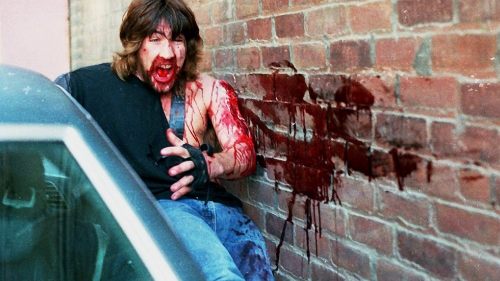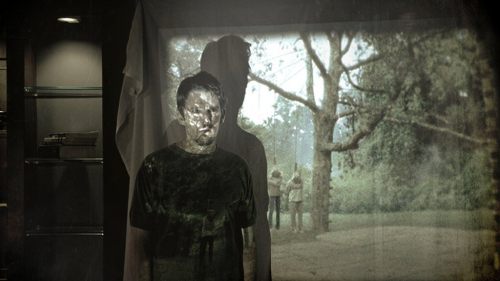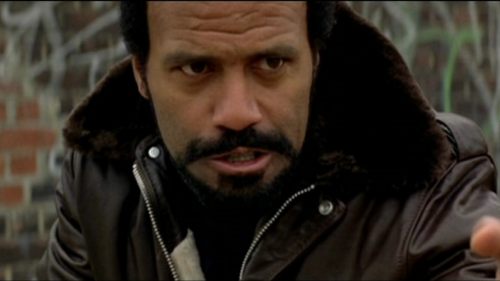The Savage Stack - TIMES SQUARE (1980)
There’s always going to be – for lack of a better term – a stack of films we’ve been meaning to get to. Whether it’s a pile of DVDs and Blu-rays haphazardly amassed atop our television stands, or a seemingly endless digital queue on our respective streaming accounts, there’s simply more movies than time to watch them. This column is here to make that problem worse. Ostensibly an extension of Everybody’s Into Weirdness (may that series rest in peace), The Savage Stack is a compilation of the odd and magnificent motion pictures you probably should be watching instead of popping in The Avengers for the 2,000th time. Not that there’s anything wrong with filmic “comfort food” (God knows we all have titles we frequently return to when we crave that warm and fuzzy feeling), but if you love movies, you should never stop searching for the next title that’s going to make your “To Watch” list that much more insurmountable. Some will be favorites, others oddities, with esoteric eccentricities thrown in for good measure. All in all, a mountain of movies to conquer.
The seventy-sixth entry into this unbroken backlog is Allan Moyle's visual poem dedicated to kids growing up in the gutter, Times Square...

While perusing the neon-lit storefronts of the gigantic, open-air shopping mall that is New York’s Times Square, its difficult not to want to uncover signs of the old 42nd Street: marquees that once displayed XXX features, old poster casings and pornography depots. They’re still there – you just have to know where to look. Sidewalk overhangs now belong to trendy restaurants instead of grindhouses, while the smut-filled stations situated just above the street are refurbished lofts, their signs obscured by the brightly lit billboards for family-friendly Hellscapes like Ripley’s Believe It or Not Museum and several oversized haunted houses or Christmas shops (depending on the season).
Replace the concrete streets and swerving taxis with wooden planks and pothead-drawn rickshaws and the avenue could easily be distorted into a boardwalk-lined beach in New Jersey or Delaware, accessible to the clans that flock every summer to get away from the hustle and bustle of their daily lives. The faces that browse storefronts are different from the ones seen in early '80s filmic time capsules. Gone are the punks and the peddlers and the dopers and the homeless, replaced with tourists and the richest 1%, who stampede through the streets in a rush to get in line for the next gaudy attraction. Rudy Giuliani’s “Disneyfication” of Times Square is complete, as the sleaze has been washed clean by a wave of cold-cathode gas consumerism.
Allan Moyle’s Times Square (’80) is a love letter to the gritty and grimy X-Rated days of NYC. While the narrative of the film follows two young girls who fall in love on the streets, The Deuce is the picture's true lead. In a strange way, Moyle’s movie feels like the cinematic encapsulation of what this writer imagines to be many New Yorkers’ worst memories of their beloved metropolis, where danger lurked in every nook and cranny. Drug-fueled crime could strike anyone if they were in the wrong place at the wrong time, and getting into trouble in the old Times Square seemed to be its only prime attraction.
But what Times Square also taps into is how the center of the city became a weird, self-contained society of loners and weirdos, and if you just acted liked you “belonged”, nobody was going to mess with you. It was a haven for those who came to see bizarre movies and be with others who weren’t afraid of the dregs that the town collected. Sure, it could be dangerous, but there was also a beauty to the disorder – an alluringly Caligulan collection of vice that could easily be damned from a distance but also served as a haven for those crafting outsider art (just look to lo-fi auteurs such as Andy Milligan for prime examples).
Two girls are our guides. Nicky (Robin Johnson — who Moyle reportedly discovered hanging outside of a convenience store in-between casting sessions) is a loudmouth hood who wanders the seedy back alleys with her guitar, blaring riffs off of pimps’ car hoods. After one too many confrontations, she’s committed to the New York Neurological Hospital — an unsolvable case for the sanitarium’s specialists. At the other end of the social spectrum is Pam (Trini Alvarado), the nebbish spawn of a rising political star who wants to clean the crust from the sidewalks of Times Square (any modern audience is instantly going to start making Giuliani comparisons here). Constantly troubled by her father’s campaign lies, Pam has fits that cannot be diagnosed, landing her in the same asylum as her punk rock counterpart. In a rush of Ramones-inspired tomfoolery, Nicky convinces Pam to escape and live in the streets with her, poor but blissfully so.
As the girls navigate their new urban playground, they tap into the psychic energy of New York in the '80s. While junkies sneer, they find refuge in the Cleo Club, a low-end topless bar. One of the great, true moments of discovery happens on the club’s tiny runway. Nicky gets Pam a job as a waitress and even convinces the owner to let her friend dance with her clothes on. When she gets on stage, Pam is nervous at first and almost runs off as people begin to laugh. But Nicky’s eyes won’t let the girl quit, egging her on until she’s swinging her hair wildly back and forth. The crowd gets into it, loving Pam’s ability to literally throw herself into the show. It’s a beautiful, lived-in scene and the point where the picture goes from being a simple “fish out of water” tale into a full-blown chronicling of revelations as this high-class girl finds herself in the lowest part of town.
Pam isn’t the only one to truly transform in the Cleo Club. Believing every word that comes out of Nicky’s mouth to be “poetry”, her partner in crime repays the favor and gets her a gig singing with the house band, The Blondells. “Damn Dog” is what results, as Nicky morphs into a punk rock goddess before a strip club audience. The girl’s a natural, and Johnson is on fire. Nicky is a girl born for the stage, as every defiant bone in her body lends a naturalistic swagger. At the tail end of the song, she refuses to let it die, repeating the chorus over and over again as the crowd goes nuts. Johnson conveys the true joy in performance, with a wide-eyed gawk that suddenly washes every rough edge of her character away. She’s no longer a hardened street rat, but a kid realizing there is more to this sleazy microcosm than “just getting by”. It’s incredible.
Together, Nicky and Pam become “The Sleez Sisters”, discovered by late-night DJ Johnny Laguardia (Tim Curry – playing one of Lester Bangs’ noted “Uncool”). Laguardia is now an antiquated symbol, a DJ who believes that music can be used as a weapon - another reminder of how not just New York, but also the world at large, has changed in thirty years. A self-perceived intellectual sending deep thoughts out over airwaves, Laguardia is the type of local spinner that was killed by corporate takeovers. He’s a rebel that still believes he can harness rock and roll and use it to reach the masses. Laguardia even has a crew of lackeys that follow him about, believing the man's a genius. The character is a reminder that bands could be made on the FM dial. In the Sleez Sisters, he spots an opportunity to bring feminist anarchy to the masses.
Don’t get this writer wrong – Laguardia is a scumbag through and through. He revels in his “teen sex god” image and only really seeks to exploit the punk vibe of The Sleez Sisters for his own gain. He even becomes the catalyst for Pam and Nicky’s first major fight, as Nicky comes home to their squatter pad (8th Avenue's legendary gay porn palace The Adonis) and finds him laying on the bed with Pam, drinking vodka. It’s a creepy moment that fully illustrates his lecherous nature and, even though he may believe himself to be a God, he’s really just a sniveling pseudo-poet.
If there’s anything that seems off about Times Square, it’s the schism that occurs between Pam and Nicky toward the end. Apparently, Pam and Nicky’s friendship blossomed into a full-blown love affair in earlier cuts of the film. But Moyle was forced by producers to splice it almost completely out. The loss of the relationship is felt drastically toward the end, as Nicky just sort of freaks out at the sight of a man and the two separate. This excision also accounts for the jumbled, loose feel of the second act, as there are times where Times Square meanders and stumbles, as if something vital were missing. Instead, astute audience members are again relegated to picking up the queer subtext through location spotting, as the Sleez Sisters often hang out at old cruising peers, the scouting and finished product performed and perfected by a gay filmmaker.
Moyle - who would go on to take a shot at another rock and roll inspired coming-of-age tale with Empire Records ('95) - has all but disowned Times Square since its '80 release. The director and co-writer (who based the script partially on a girl’s diary they discovered after moving into a decrepit Big Apple apartment) felt that the Sisters' infatuation was the beating heart of the picture, and its loss neutered his movie of all meaning. While it's certainly easy to understand these artistic gripes, you can still very much FEEL the love without any sort of explicit sexual contact. Pam writes teenage love poems to Nicky and the two all but confess their love to one another at the end. In fact, the lack of congress actually helps reinforce how young these two really are, and that this is probably the first time either is feeling this way about another person (man or woman).
At the end of the film, 42nd Street is filled with garbage bag-wearing pubescent girls at the behest of The Sleez Sisters. It’s a sly moment of subversion retooled as an ABC Family climax. In essence, we are part of the legion who have been entranced by these two punk rock princesses. We watch them fall in love and exist in the dirt and the filth of 42nd Street from the comfort of our own home. But they make that bombed-out land their own personal paradise, letting us know that it’s safe to hang with the dopers, druggies and other miscreants. As the final shot pulls back, we see a line of grindhouse marquees advertising everything from exploitation oddities to small-scale dramas. There’s art in these streets, all it takes is for us to be brave enough to find it.
Times Square is available now on a sadly OOP DVD edition.



